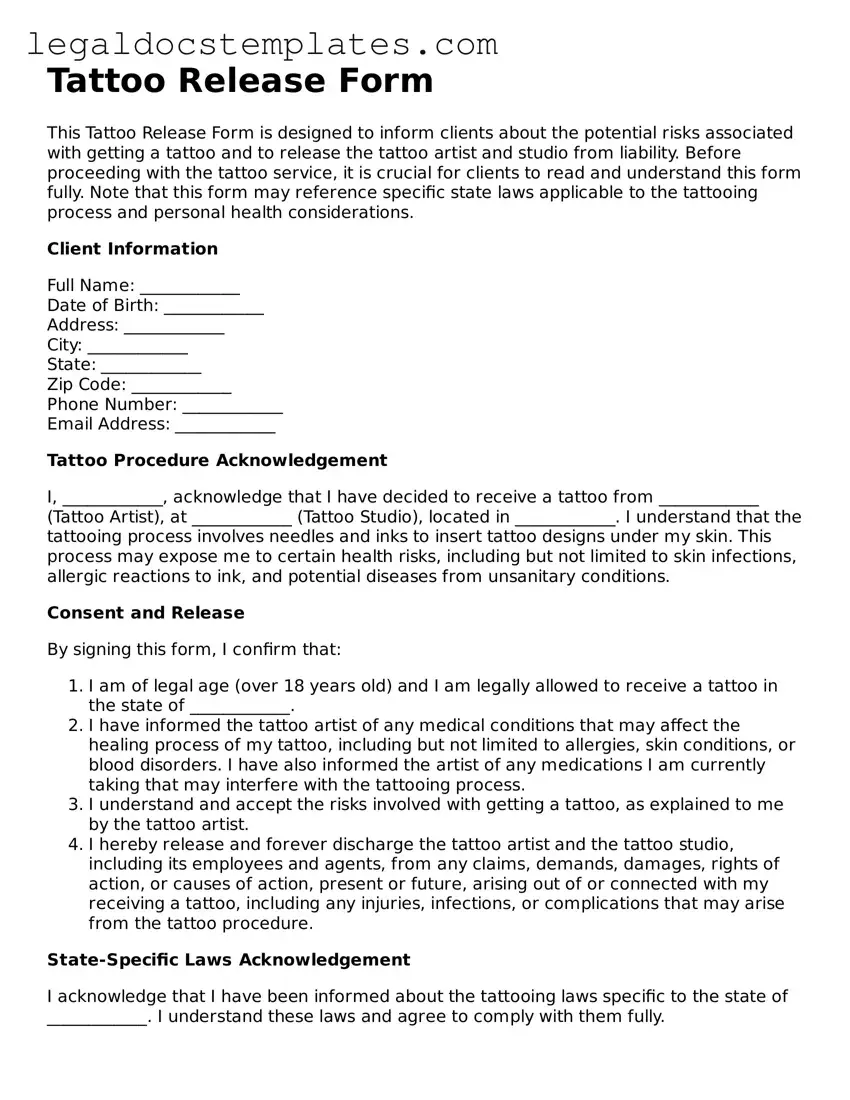The Tattoo Release Form shares similarities with a Medical Consent Form, as both documents are crucial in ensuring that the individual has been adequately informed about the procedures they are about to undergo, understanding the associated risks and possible outcomes. In both cases, these forms play a critical role in protecting service providers from liability claims, by confirming that clients or patients have been made aware of all relevant information for making an informed decision.
Similarly, a Photo Release Form echoes the Tattoo Release Form in terms of content and purpose. It is designed to obtain an individual's consent before their image or likeness is captured and used, potentially in public or commercial settings. Both forms are preventative measures designed to safeguard against future disputes by recording explicit permission from the subjects involved, thus highlighting the importance of consent in professional interactions.
Another analogous document is the Liability Waiver Form, commonly used in events or activities that involve a degree of risk. Like the Tattoo Release Form, it functions to inform participants of potential dangers while simultaneously absolving the organization or individual in charge from legal responsibility for any injuries sustained. This parallel underscores the forms’ role in managing risk and protecting service providers legally.
The Informed Consent Form, often utilized in research or medical treatment settings, bears resemblance to the Tattoo Release Form as well. Both documents ensure that individuals are fully aware of what they are consenting to, including any potential risks, benefits, and outcomes. The primary purpose here is to document the individual's agreement to proceed, after having all the necessary information to make an informed decision.
A Service Agreement Contract, while broader in scope, shares the foundation of outlining terms and conditions of a service, similar to what is found in a Tattoo Release Form. Both ensure that the service provider and the client are on the same page regarding what will be provided, expectations from both parties, and any terms related to liability or responsibility. This similarity highlights the importance of clear communication and mutual understanding in professional engagements.
Furthermore, the Participant Release Form used in competitions or workshops has a similar function to the Tattoo Release Form in that it obtains agreement from participants regarding their understanding of and consent to the risks involved. It also typically includes clauses that protect the hosting organization from liability, emphasizing the preventative role these documents play in any organized activity.
The Property Release Form, used when photographers or filmmakers need permission to use someone’s property in their work, parallels the Tattoo Release Form in its essence of obtaining consent. Although one focuses on personal property and the other on personal body art, both delineate terms under which the subjects’ properties or images can be used, ensuring respect for personal and intellectual property rights.
Last but not least, the Minor Consent Form specifically caters to situations involving individuals under the legal age of consent, requiring a parent or guardian’s signature to authorize participation in activities, medical treatments, or other services. This is akin to the Tattoo Release Form whenever tattoos are to be applied to minors in jurisdictions that allow it, with both forms aiming to ensure legal and ethical compliance in providing services to younger individuals.
